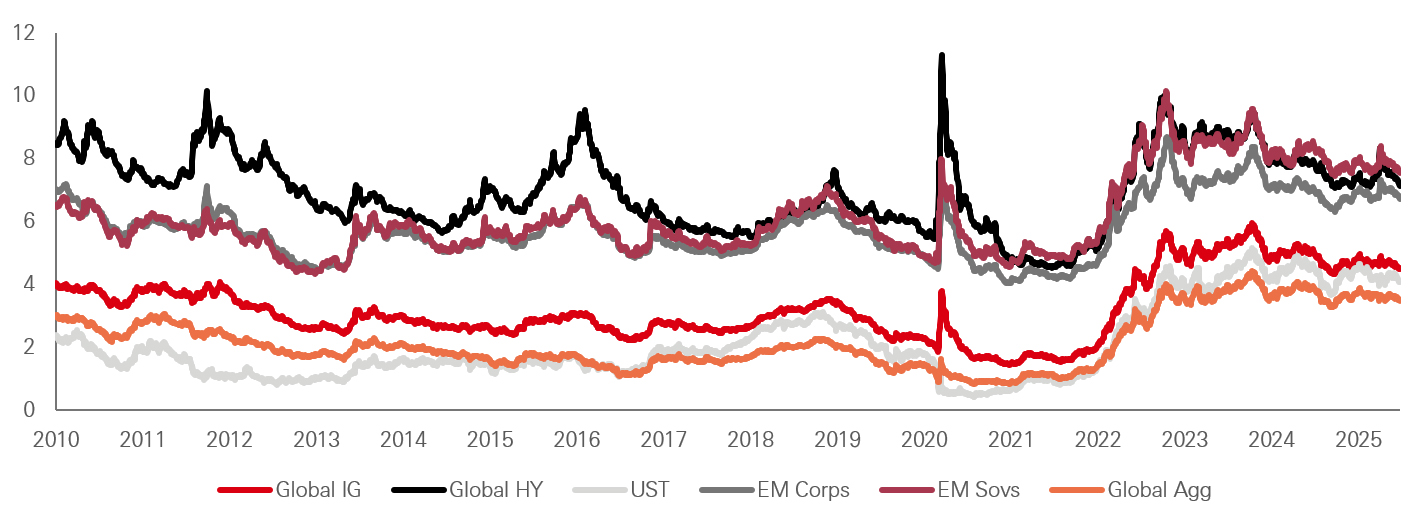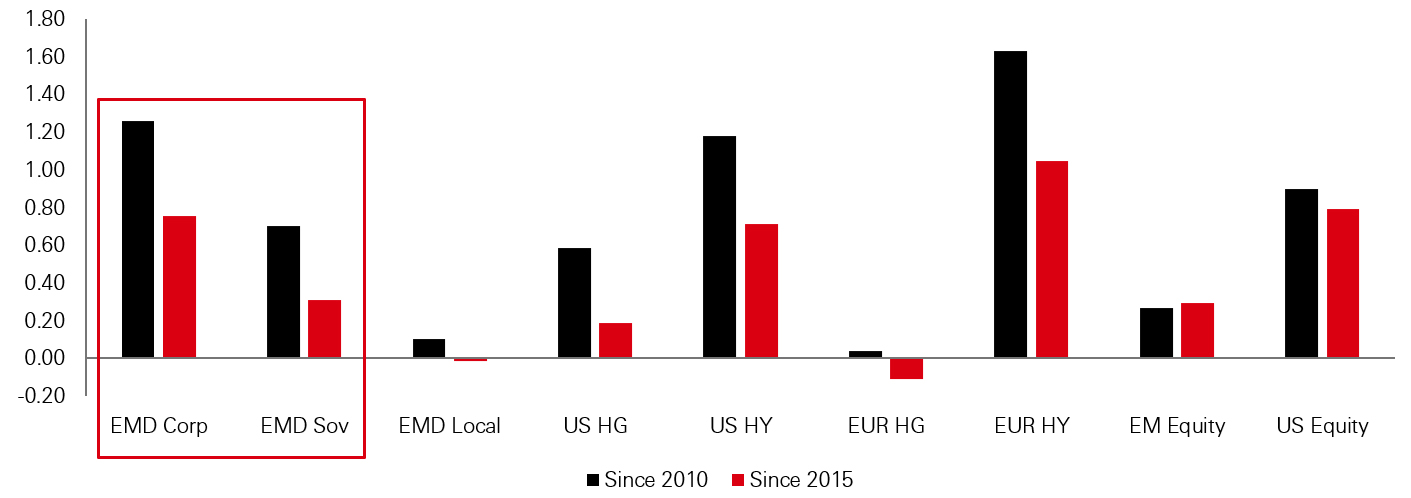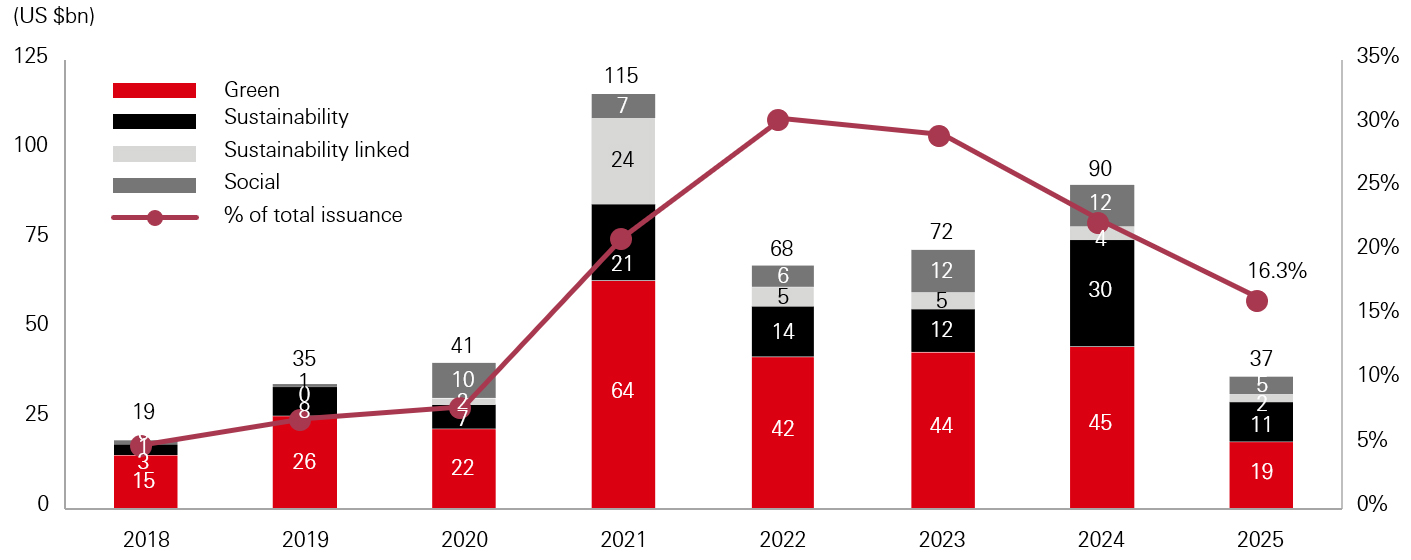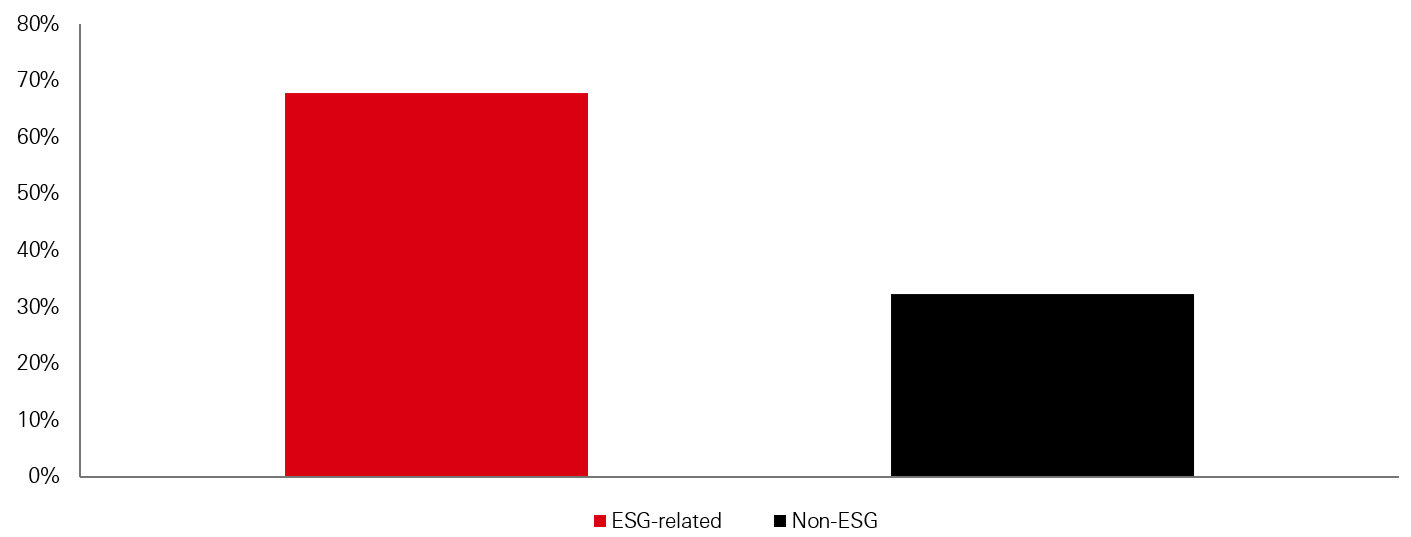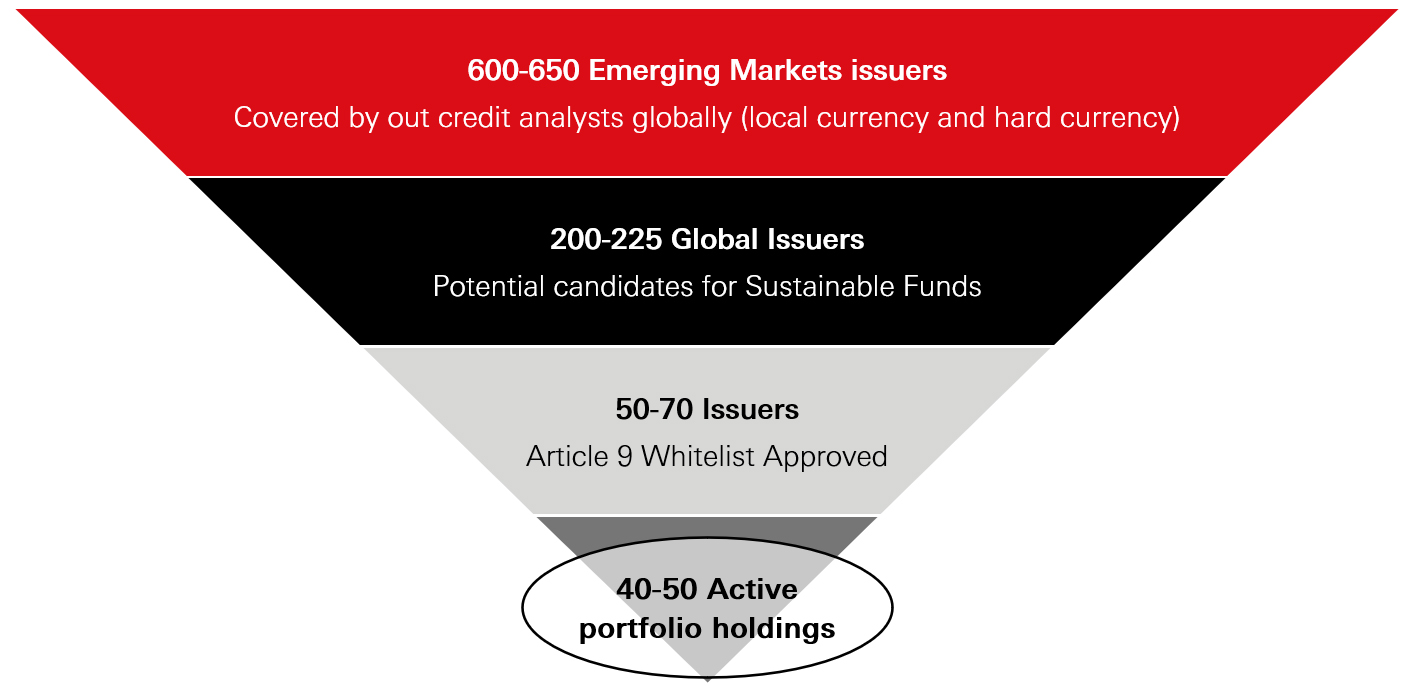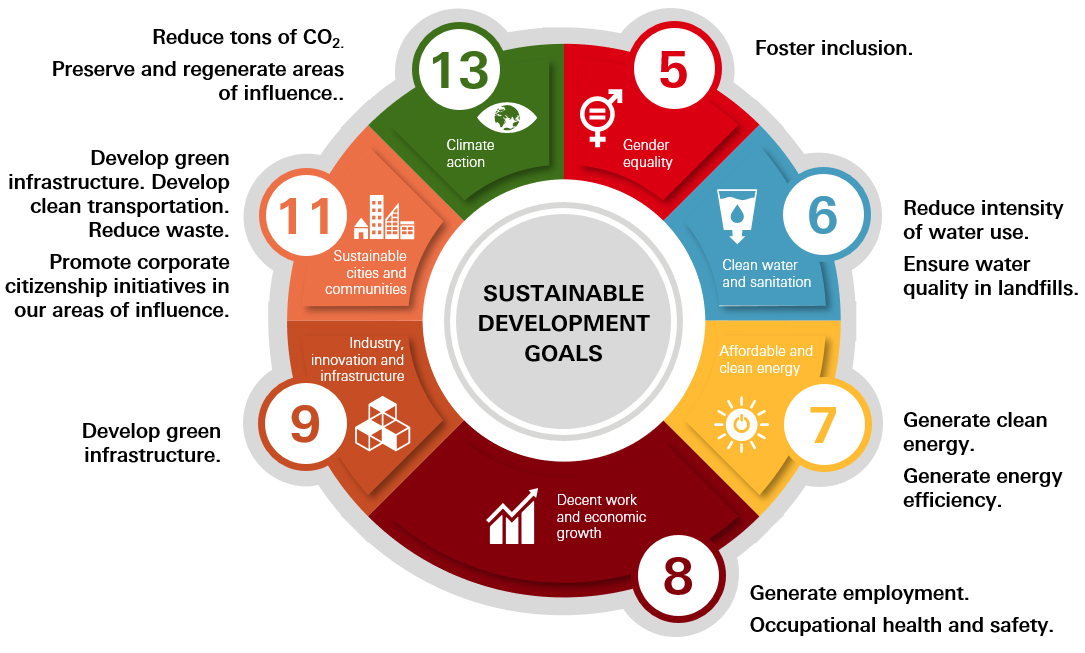Sustainable Emerging Markets Debt
Introduction
The International Financial Corporation (IFC) has collaborated with HSBC Asset Management to develop an innovative sustainable emerging markets corporate bond strategy, closely modelled on the existing HGIF Global Emerging Markets Corporate Sustainable Bond fund.
This new strategy aims to mobilise financing for sustainable transitions across emerging markets. It seeks to invest in emerging markets companies actively pursuing sustainable practices or implementing ambitious, measurable and sustainability plans. In alignment with Sustainable Finance Disclosure Regulation (SFDR) Article 9 principles, the strategy aims to generate positive environmental and social outcomes and to deliver long-term financial returns for investors.
In this paper, we discuss the ambitions of our partnership with the IFC and how the objectives and investment process of this new strategy align with these goals.
Emerging Markets Corporates: asset class growth and resilience
Emerging Market (EM) corporates have matured and developed into their own robust asset class. They now have a face value of c. USD 1.2tn, approaching the size of the US High Yield market (see Figure 1).
Evolution of Corporate Indices (Figure 1)
Source: JP Morgan, ICE BofA, as of 30 June 2025 based on daily returns. For informational purposes only. Index returns do not reflect any fees, expenses or sales charges associated with investing. Investors cannot invest directly in an index.
Nevertheless, EM corporates are still somewhat orphaned as an asset class, lacking dedicated investors. We believe that EM corporate debt has several attractive attributes that are not as widely appreciated as they should be.
Diversification. The EM corporates universe provides a diversified global set of countries and industries so that it is not beholden to a single economic cycle or central bank policy. The asset class is also hybrid, composed of both investment grade and high yield issuers (with over 50 per cent investment grade).
Robust risk management. EM companies tend to be better managed than their DM counterparts, even on a ratings-adjusted basis; they generally have lower leverage levels, more debt prudence, more consistent currency hedging, and can withstand periods when markets are closed, holding their value regardless of the interest rate environment.
Resilient yields. The most widely-used EM Corporate bond index (the JPM CEMBI BD) has delivered higher carry and lower volatility than other credit asset classes over the longer term—especially during drawdowns (see Figure 2).
Fixed Income Asset Class Yields (per cent) (Figure 2)
Performance for EM corporates is not driven primarily by flows. Spreads by rating groups tend to be higher and more stable than their respective developed markets counterparts. Performance is also less correlated to US Treasuries than other asset classes. With this lower correlation, higher yields, lower duration, and investor base differences, EM corporates can help diversify and stabilise a portfolio’s risk-adjusted returns over the longer-term (Figure 3).
Sharpe ratio by asset class (Figure 3)
Past performance does not predict future returns. The level of yield is not guaranteed and may rise or fall in the future.
Source: Morningstar, MSCI, JP Morgan, ICE BofA, and S&P as of 30 June 2025 based on daily returns.
Emerging markets corporates outlook. The outlook for EM corporate bonds is encouraging, based on the macroeconomic cycle, country fundamentals, bottom-up company strength, and technical factors. The yield advantage of EM corporates may be compounded by the capital gain effect of cyclically declining interest rates, providing a once-in-a-decade opportunity for strong returns.
Sustainable investing opportunities in Emerging Markets Corporates
Sustainable investing in emerging markets has reached an inflection point. The issuance of Green, Social, and Sustainability-linked bonds in EM grew from USD 20bn in 2018 to nearly USD 90bn in 2024, reflecting growing investor interest and broader and deeper issuer participation. (See figures 4 and 5).
EM Corporate GSS bond issuance by type and per cent of total (Figure 4)
Source: JPM, BondRader as of 30 June 2025.
Despite this growth, a significant gap remains in financing for issuers that meet sustainability criteria requirements but lack labelled bonds or traditional funding mechanisms. Overall, EM corporates have fewer funding sources for transition and sustainability initiatives.
HSBC Asset Management created a sustainable emerging markets corporate bond strategy to help fill this funding gap. With the support of the IFC, the strategy aims to contribute to the institutionalisation of sustainable investing in EM. This innovative strategy is well-positioned to meet the demand from investors that are formalising their SFDR Article 9 and ‘impact’ allocations and looking for opportunities that are aligned with the Paris Agreement and the UN Sustainable Development Goals (SDGs).
ESG related funds comprise two-thirds of EMD universe (Figure 5)
Source: Morningstar as of 30 June 2025.
The views expressed above were held at the time of preparation and are subject to change without notice. Any forecast, projection or target where provided is indicative only and not guaranteed in any way.
Financing the transition to sustainability
Alongside the IFC, HSBC Asset Management see a remarkable opportunity to help finance a sustainable transition for EM corporates at a time when they require more capital.
Unlike traditional emerging markets ESG funds that tend to focus on use-of-proceeds and labelled bonds (e.g., Green, Social, or Sustainability-linked bonds), we have created an EM corporate bond strategy that takes a broader and more flexible approach, targeting companies with transformative sustainability goals and demonstrated business plans and ambitions. This strategy identifies companies with clear improvement potential; it selects investments that meet the high standards of SFDR Article 9, ensuring transparency, accountability and alignment with the UN’s Sustainable Development Goals.
Our objective. The HSBC Global Emerging Markets Corporate Sustainable Bond strategy aims to institutionalise sustainable investing in EM corporates and to draw attention, resources, and capital to EM issuers that are on a specific path to achieving specific sustainability goals. By channelling capital into companies actively implementing ambitious, measurable sustainability plans and practices, the strategy seeks to catalyse environmental and social change while delivering long-term financial returns.
With its focus on fostering companies that show strong and measurable commitments to greater sustainability, the strategy aims to identify a new source of alpha—ultimately by predicting sustainability advancement over time. Aiming to prioritise sustainability improvements as a driver of future financial returns has the potential to help expand what it means to invest sustainably in emerging markets.
Strategy profile: HSBC Global Emerging Markets Corporate Sustainable Bond
The HSBC Global Emerging Markets Corporate Sustainable Bond strategy seeks to deliver positive long-term returns while driving meaningful progress in EM sustainability.
How we invest. The strategy applies a credit-intensive, engagement-driven investment approach. Through a rigorous bottom-up approach, we evaluate an issuer’s sustainability plans, its progress toward achieving specific ESG goals, and its alignment with SDG themes.
Our deliberative, deep-dive analytical process for evaluating portfolio candidates can exclude close to 90 per cent of the issuers across the EM corporate bond universe—although we do not eliminate potential issuers with a target percentile in mind. (See Figure 6)
Figure 6
Source: HSBC Asset Management as of 30 June 2025 . The views expressed above were held at the time of preparation and are subject to change without notice. Any forecast, projection or target where provided is indicative only and not guaranteed in any way. Representative overview of the investment process, which may differ by product, client mandate or market conditions.
By expanding the investment universe beyond labelled bonds, the strategy not only targets companies that meet our stringent sustainability and ESG criteria but aims to create a diversified portfolio in terms of industries, regions and ratings. This diversification tends to be broader than that of other EM sustainable or impact funds that focus more narrowly on labelled bonds.
We invest in companies at various stages of their sustainability lifecycle and then reallocate capital as they achieve their goals—while aiming to maximise the strategy’s impact across sectors and regions. We aim to invest in issuers before their sustainability improvements are incorporated into market prices. Then, we can harvest the potential price appreciation achieved through these improvements and invest in new opportunities for sustainable co-investment.
Issuer engagement. Ongoing engagement with EM corporate issuers is central to our strategy. We engage with all companies —helping with lighter-touch sustainability improvements or providing higher-pressure conditional criteria for achieving measurable impact. Our analyst teams collaborate closely with corporate management teams to foster transparency, encourage ESG data disclosure, and track progress against sustainability milestones. This ongoing dialogue with issuers enhances our fundamental credit research process and ensures the portfolio remains aligned with SFDR Article 9 standards.
Alignment with UN SDGs. The strategy does not have a singular thematic focus. We look for sustainable transition and potential impact everywhere and anywhere we can; therefore, our bottom-up issuer selection process and engagement results in a portfolio that can express a range of sustainability goals.
The SDGs captured in our portfolio include Climate Action (13), Affordable and Clean Energy (7), Clean Water and Sanitation (6), Good Health and Well Being (3) and Reduced Inequalities (10), across a diversified set of regions and sectors. (See Figure 7.)
United Nations Sustainable Development Goals (Figure 7)
The views expressed above were held at the time of preparation and are subject to change without notice. Any forecast, projection or target where provided is indicative only and not guaranteed in any way.
Investor benefits. The strategy channels capital into promising emerging markets issuers that we believe to be future winners of global transition and change. With robust credit research, active engagement, and strategic capital allocation, we aim to drive meaningful and measurable impact in emerging markets—both environmental and social—and to deliver attractive long-term risk-adjusted returns.
The strategy aims to provide an investment portfolio with:
- a high-growth, high-yielding and diversified investment opportunity in emerging markets corporates, leveraging a labour-intensive, engagement-based investment process
- a way to capture a significant portion of the improvement evolution (and the potential price appreciation) of these companies,
- a low annual turnover rate (30-50 per cent annually), helping to protect investors from the transaction costs that are often associated with EM investing
Conclusion
The HSBC Global Emerging Markets Corporate Sustainable Bond strategy is positioned to address a critical market gap: the lack of financing for sustainability transition across EM companies. With EM companies producing the lion’s share of global carbon emissions, and the lack of capital to finance needed investment, our approach targets a void in the universe of investment strategies. By aligning with SFDR Article 9 standards and leveraging the support of key institutional partners like the IFC, the strategy aims to mobilise capital for sustainable initiatives across the emerging world.
We believe that our investment approach—prioritising sustainability improvements as a driver of financial returns—can help to redefine investing in emerging markets. Through robust research, active engagement, and strategic capital allocation, the strategy seeks to deliver positive environmental and social impact while delivering long-term value to investors by selecting future winners of global transition and change.
We anticipate that the need for private financing to achieve progress in EM sustainability will grow and broaden. We believe that our strategy provides a scalable and impactful solution today to that future need, helping investors with a solution to align their portfolios with the transition to a greener, more sustainable future.



